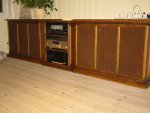I'm trying to get a few basics straight, and this seems like a good place to ask.
I have read that at some SP level, the air in a horn throat can distort. Does this happen (even if only on transients on un-compressed signals) at or near the 'loud end' of studio monitoring? (Let's say just to get in the ballpark loud is 100db spl on the average scale and peaks are +8 or 10 above.)
Second-..
Does driver efficiency have an effect on the relative dynamics of the output sound pressure level? This would assume that the systems, a high efficiency and a lower in comparison are both operating within their linear range (not being drive into 'power compression', if that is the applicable term).
I think the answer is no, but would like to be sure, and comes from hearing people say some system might sound 'more dynamic' than others.
And last, it has been said that a cone design may have an edge (potentially?) in the accuracy department over horns.
(It's new studio monitor time.
Thanks in advance.
Wayne Smith




 Reply With Quote
Reply With Quote






